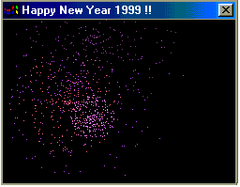Happy99
 | |
| Aliases | Ska, I-Worm |
|---|---|
| Type | Computer worm |
| Author(s) | "Spanska" |
| Port(s) used | 25, 119[1][2] |
| Operating system(s) affected | Windows 95, Windows 98, Windows NT[3] |
| Filesize | 10,000 bytes |
Happy99 (also termed Ska or I-Worm)[4] is a computer worm for Microsoft Windows. It first appeared in mid-January 1999, spreading through email and usenet. The worm installs itself and runs in the background of a victim's machine, without their knowledge. It is generally considered the first virus to propagate by email, and has served as a template for the creation of other self-propagating viruses. Happy99 has spread on multiple continents, including North America, Europe, and Asia.
Significance
Happy99 was described by Paul Oldfield as "the first virus to spread rapidly by email".[5] In the Computer Security Handbook, Happy99 is referred to as "the first modern worm".[6] Happy99 also served as a template for the creation of ExploreZip, another self-spreading virus.[7]
Spread
The worm first appeared on 20 January 1999.[8] Media reports of the worm started coming in from the United States and Europe, in addition to numerous complaints on newsgroups from users that had become infected with the worm.[9] Asia Pulse reported 74 cases of the virus from Japan in February, and 181 cases were reported in March—a monthly record at the time.[10][11] On 3 March 1999, a Tokyo job company accidentally sent 4000 copies of the virus to 30 universities in Japan.[12]
Dan Schrader of
Technical details
The worm spreads through email attachments and Usenet.[19][20][21] When executed, animated fireworks and a "Happy New Year" message display.[19][22] The worm modifies Winsock, a Windows communication library, to allow itself to spread.[19] The worm then attaches itself automatically to all subsequent emails and newsgroup posts sent by a user.[23] The worm modifies a registry key to automatically start itself when the computer is rebooted. In some cases, the program may cause several error messages to appear.[24]
The worm was written by a French virus writer known as "Spanska". Other than propagating itself, the worm does no further damage to an infected computer.
See also
- List of computer worms
- Timeline of computer viruses and worms
- Comparison of computer viruses
- E-mail spam
- Malware
References
- ISBN 1-59749-109-8.
- ISBN 0-8493-1290-6.
- ^ George Skarbek (16 March 1999). "Tech talk - Happy99 Virus". The Courier-Mail.
- ISBN 1-56592-682-X.
- ISBN 0-9538336-0-7.
- ISBN 0-471-26975-1.
- ^ Rosie Lombardi (2 July 1999). "Microsoft's dominance plays a role". Computing Canada.
- ISBN 0-12-421161-5.
- ^ David Watts (16 February 1999). "Help Desk". The West Australian.
- ^ "251 Cases of Computer Virus Damage Reported in Japan in Feb". Asia Pulse. 7 March 1999.
- Asahi Shimbun.
- ^ "Virus-tainted e-mail sent to 4,000". The Daily Yomiuri. 6 June 1999.
- ^ Clint Swett; Eric Young (7 April 1999). "Tech Talk Column". The Sacramento Bee.
- ISSN 0956-9979.
- Adelaide Advertiser. 19 February 2000.
- ^ "Virus variants put users at risk Users are at risk from new variants of popular viruses which can evade some antivirus protection". World Reporter TM. 6 March 2000.
- ^ Deborah Scoblionkov (2 March 1999). "Bigfoot Users Get a Hotfoot". Wired.
- ^ Jeffrey Kosseff (15 September 2003). "Virus-Hunters Scour Internet with 'Dirty' Computers". The Oregonian.
- ^ ISBN 0-8247-5939-7.
- ISBN 0-471-27351-1.
- ^ Roberta Fusaro (29 January 1999). "Internet worm can crash corporate servers". CNN.
- ^ ISBN 0-201-71114-1.
- ^ Carrie Kirby (22 December 2000). "Holiday E-Mail Gives Viruses An Opportunity". San Francisco Chronicle.
- ^ a b Grover, Amit (August 2003). "Application Adaptive Bandwidth Management Using Real-Time Network Monitoring" (PDF): 77–78. Archived from the original (PDF) on 14 September 2006. Retrieved 27 March 2009.
{{cite journal}}: Cite journal requires|journal=(help) - ISBN 0-7897-2125-2.
- ISBN 0-7234-3357-7.
- ZDNet.[permanent dead link]
